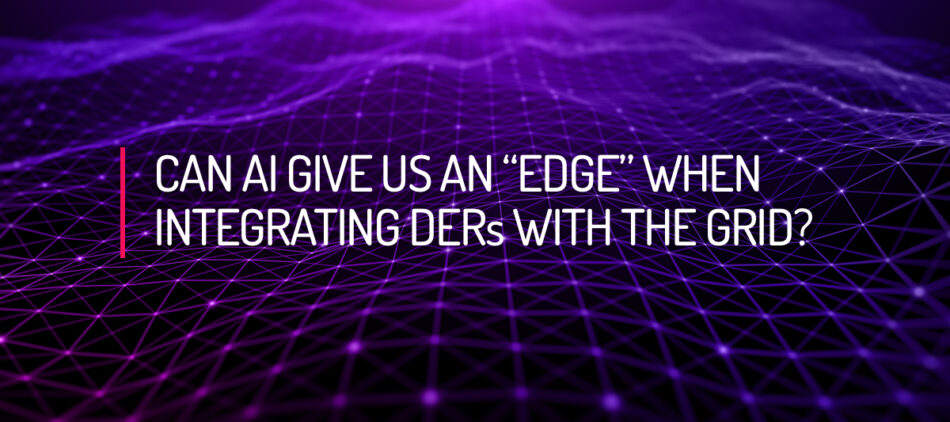
Can AI Give Us an “Edge” When Integrating DERs with the Grid?
Welcome to the 3rd installment in our series on America’s aging electricity grid and the nation’s mission to rapidly decarbonize:
- Part 1 explored the unique challenges utility grid operators face when managing increasingly diverse renewable energy sources like commercial wind power or residential solar.
- Part 2 covered the growing potential of artificial intelligence (AI) to both Forecast future power demand and Optimize existing energy generation technologies for maximum grid reliability.
In the quest to decarbonize, however, grid optimization can only take us so far. This is true even when using advanced AI technology to make better predictions and decisions than human actors can. For real-time optimization models to be useful, they must be deployed across the entire grid – including to edge-devices outside the direct control of grid operators. Do this, and we will finally have a virtual power plant (VPP) in which all energy assets work in harmony to deliver reliable electricity at the right time, to the right place, and at the right price.
This article explores why this transition hasn’t happened yet. And it also covers how recent technological advancements have helped move us closer to a truly unified power grid.
Why Grid Operators Still Feel a False Sense of “Control”
Making the grid more reliable is everyone’s goal. But the modern grid has grown beyond the power stations and transmission lines we normally imagine. Today, it also encompasses edge-devices like photovoltaic (PV) panels, solar inverters, on-site batteries, and other distributed energy resources (DERs). These edge-devices often lack the flexibility to independently adjust to sudden changes in variables like voltage or demand. And this results in a host of problems, including:
- Grid congestion
- Energy imbalances
- Suboptimal device performance
Left unchecked, these smaller problems can then lead to more serious issues, like:
- Blackouts and outages
- Shorter device lifespans
- Equipment damage
These challenges exist even in relatively stable grid environments, with something as simple as a passing cloud creating minor dips in solar panel performance. But the problem becomes greatly compounded when dealing with extreme weather conditions or unexpected surges in demand – both of which will become more frequent and severe as climate change worsens.
With the right level of real-time device control and synchronization, however, it’s possible to avoid these pitfalls so that distributed energy resources work more harmoniously with one another – and the grid as a whole.
How Dynamic Device Control and Synchronization Work
Using AI-based energy demand forecasting and real-time supply optimization, Veritone Controller dynamically “controls” edge-devices – complete with the ability to synchronize them with existing electricity networks for optimal grid reliability. More specifically, Veritone’s Controller technology uses sensors and real-time data to instantly adjust distributed energy resources to smooth out imbalances in frequencies, waveforms, voltages, and other variables that might overstress edge-devices or result in reduced power delivery.
Veritone Controller accomplishes this using customizable rules you create – from transmission protocols and device parameters to industry regulations and utility network rules. In addition to stabilizing power delivery, this level of control also helps to extend device longevity by eliminating the types of power overloads and sudden fluctuations most responsible for malfunctions. Better still, Veritone Controller can do this in real-time using up-to-the-second data from Forecaster and Optimizer – both of which rely on Hamiltonian-based machine learning models that sense and instantly adjust to changing supply, demand, weather conditions, and other grid-related parameters. This real-time control allows you to deliver the optimal amount of energy – at the right time and to the right place.
Veritone Controller is able to consistently deliver these benefits even when grid conditions change dramatically – whether due to sudden spikes in energy demand or superstorms knocking down power lines.
Is Veritone Controller Right for You?
Everyone benefits when distributed energy resources work in sync with the electricity grid to deliver reliable power – particularly when the energy produced comes from renewable sources like solar and wind. As such, there are many potential applications of this powerful technology.
However, Veritone Controller offers the most obvious and immediate benefits for:
- Utilities and independent operators tasked with delivering reliable electricity and demand response for millions – often atop an aging grid that is increasingly difficult to manage as we decarbonize.
- Battery and device manufacturers who can offer better lifetime performance and longer warranty coverage if they know their products will be intelligently synchronized and controlled using AI-driven prediction models.
To learn how Veritone’s Dynamic Device Control and Synchronization technology is helping to reshape the country’s rapidly greening grid, contact us today – or download our free Intelligent Control Solution Brief.